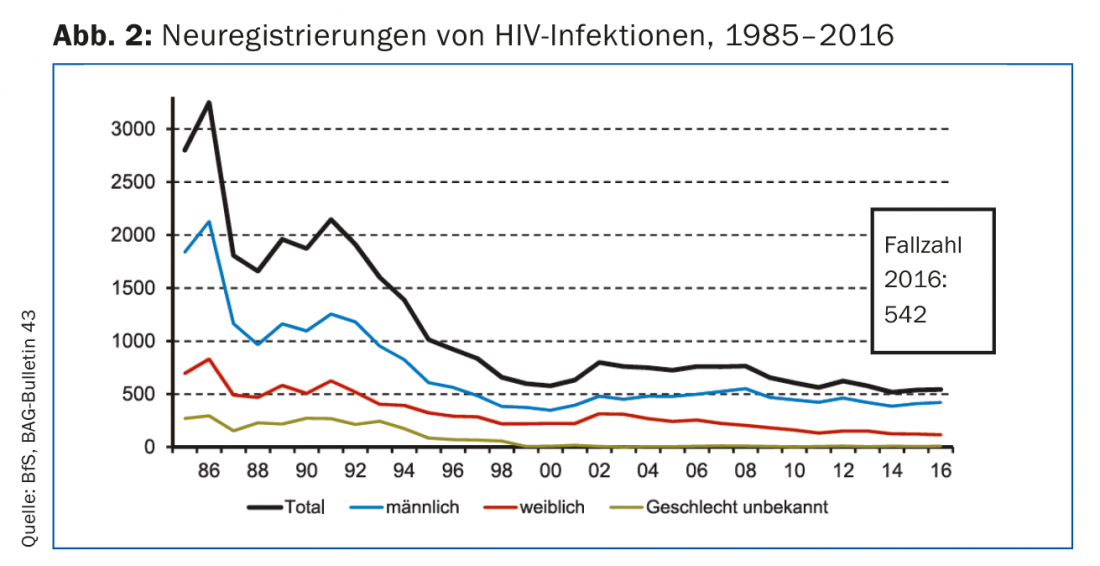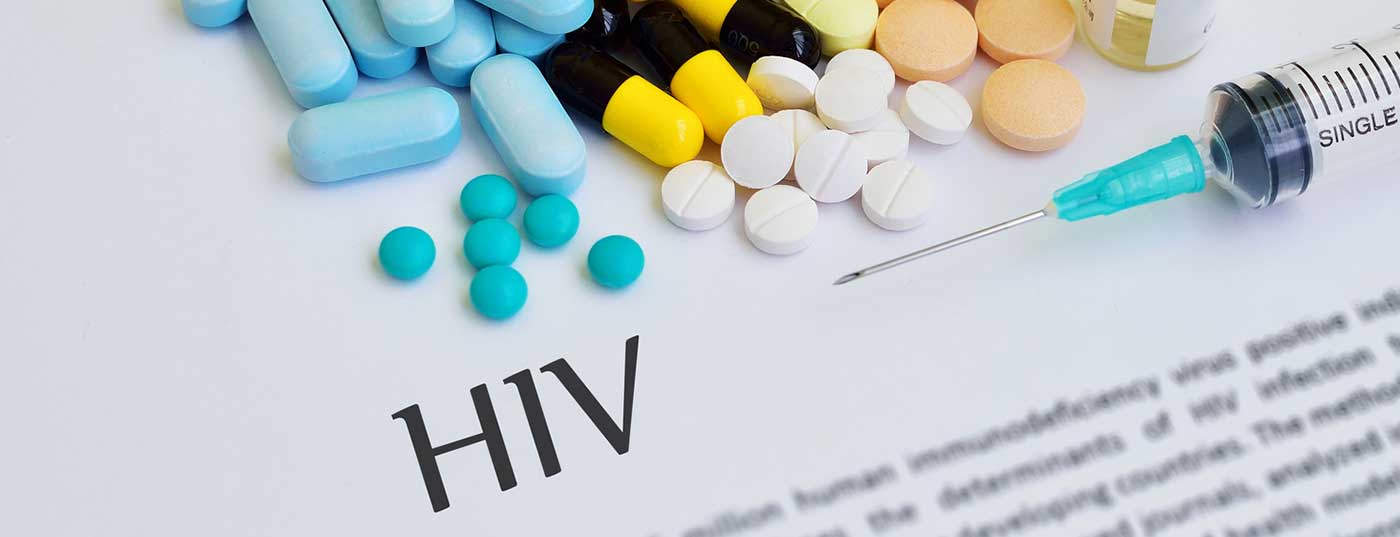In 2013, the Federal Office of Public Health rejected the introduction of HIV tests for self-testing. Now the procedure has been approved for Switzerland. What are the advantages and risks of the so-called home test? What do previous studies say? A review including an interview with Dominique Braun, MD, senior physician at the Clinic for Infectious Diseases and Hospital Hygiene at the USZ.
In 2012, the USA was the first country to introduce HIV testing for self-testing, followed by other countries such as France and Italy. As of June 19, 2018, so-called HIV self-tests or home tests may now also be sold in Switzerland. Whereas testing for HIV was previously only possible at a doctor’s office, at designated testing centers or in a hospital, anyone can now test themselves for HIV infection within 15-30 minutes using the self-test kit and a drop of blood from the fingertip. The Therapeutic Products Agency Swissmedic thus follows the recommendation of the Federal Commission for Sexual Health (FCSH) and the Federal Office of Public Health (FOPH). Figure 1 provides an overview of the current global distribution of HIV self-testing (HIVST).

Anonymous and low-threshold
As recently as 2013, the self-testing procedure had been rejected on the grounds that the tests were qualitatively insufficient in terms of sensitivity and specificity. The new EKSG report now argues that the use of HIV self-testing is now regulated by EU authorities and positive study results indicate a “favorable benefit-risk profile” [1]. The hope is that people who have not yet dared to take the step to the testing center will also use the low-threshold access to test themselves anonymously.
The approval of the home testing procedure came as a surprise to both distributors and manufacturers. After initial supply problems, the supply has now leveled off. In order to inform the public, the Swiss AIDS Federation, together with Sexual Health Switzerland and pharmasuisse, has developed various offers, explains Andreas Lehner, Executive Director of the Swiss AIDS Federation. “At www.aids.ch/selftest, the target group can find the most important information for self-testing. For this purpose, we have developed an algorithm that helps pharmacy staff to advise customers. Furthermore, we have supplemented our eLearning tool with a corresponding chapter.” Andreas Lehner is pleased about the approval: “The Swiss AIDS Federation supports all efforts to detect and treat HIV infections early”.
The kit is available at official dispensaries such as pharmacies and drugstores, as well as on the Internet. However, the Federal Office of Public Health and Swissmedic advise against online purchases where there is an increased risk of acquiring counterfeits. There are no official recommendations for products from specific manufacturers. However, only tests that meet the legal requirements may be sold. For example, the test must be designated for self-testing. In addition, the product must have the CE marking, with which the manufacturer confirms its safety and medical-technical performance in accordance with the EU Directive. The purchase price is between 40 and 70 francs, depending on the product. In Switzerland, these costs are not covered by compulsory health insurance.

The 90-90-90 goal and first experiences with HIVST
By 2020, the UNAIDS global strategy aims to meet the 90-90-90 target: 90% of all infected people know their serostatus; 90% receive antiretroviral therapy (ART); viral suppression occurs in 90% of all ART-treated people [2]. Here, tests for self-administration make an important contribution, because people from risk groups in particular often shy away from visiting a doctor or hospital for fear of stigmatization, criminalization, or unfriendly service [3]. Low-threshold, anonymous access to testing opportunities is intended to reach these individuals [4]. In this country, the number of newly registered HIV cases has decreased significantly since the beginning of the measurements in 1985 (Fig. 2). However, the Federal Statistical Office assumes that around one fifth of those affected in Switzerland are unaware of their own infection [5]. Worldwide, the figure is 40-45% [6]. The plan to reach people who do not or rarely get tested seems to be working: In an Australian randomized study, four times as many people from this target group took the self-test compared with the control group, which used conventional methods. HIV self-testing also doubled the frequency of testing among homosexual or bisexual men at increased risk of infection [7]. Positive experiences have also been made in France, where HIVSTs have been allowed to be sold since 2015. However, it is still too early for our neighbor to draw a conclusion – and even more so here in Germany: “Certain tests are not even available on the market yet. We will certainly be able to provide good information towards the end of the year,” says Andreas Lehner. We are looking forward to the first interim report.
Literature:
- Federal Office of Public Health: Recommendations of the Federal Commission for Sexual Health (FCSH) on the distribution of HIV tests for self-testing (“HIV self-tests”) to the public. FOPH Bulletin 25, June 18, 2018.
- UNAIDS: 90-90-90. An ambitious treatment target to help end the AIDS epidemic. 2017. www.unaids.org/en/resources/documents/2017/90-90-90.
- WHO: Consolidated guidelines on HIV prevention, diagnosis, treatment and care for key populations. 2014. www.who.int/hiv/pub/guidelines/keypopulations/en.
- WHO, Unitaid: Market and technology landscape. HIV rapid diagnostic tests for self-testing, 3rd edition. 2017. www.who.int/hiv/pub/vct/unitaid-landscape-hivst-2017.pdf?ua=1.
- Kohler P, et al: The HIV care cascade in Switzerland: reaching the UNAIDS/WHO targets for patients diagnosed with HIV. AIDS 2015; 29: 2509-2515.
- UNAIDS: Prevention Gap Report. 2016. www.unaids.org/sites/default/files/media_asset/2016-prevention-gap-report_en.pdf.
- Jamil MS, et al: Effect of availability of HIV self-testing on HIV testing frequency in gay and bisexual men at high risk of infection (FORTH): a waiting-list randomised controlled trial. Lancet HIV 2017; 4: e241-e250.
Interview
A lot of potential – and some dangers
In your experience, which testing services are used and how often?
Dr. Dominique Braun:
The standard is still the laboratory test, a 4th generation test, which is performed with the help of venous blood sampling. This combined test can detect both p24 antigen and antibodies. In certain cases, antibodies are not measurable until twelve weeks after the risk situation, whereas the p24 antigen is already measurable after the first three weeks. This reduces the diagnostic window. However, venous blood sampling and laboratory testing must be performed by professionals. Then there is the rapid test, also a 4th generation test performed at test sites. The advantage is that the blood collection is capillary and the result can be discussed with the patient after twenty minutes. Certain rapid tests can detect the p24 antigen, but these are somewhat less sensitive compared to the laboratory test. The so-called home test, in turn, is based – as a 3rd generation test – only on antibody detection. The home test therefore does not reliably rule out HIV infection until 12 weeks after a risk situation. Which test people choose to be tested depends on the setting. Most do the laboratory test, for example at the University Hospital in Zurich. Test centers such as Checkpoint Zurich, which often have a different clientele, also offer rapid tests, the results of which are then discussed immediately.
Who is getting tested?
At the University Hospital Zurich, where laboratory tests are performed anonymously twice a week, 90% of patients are heterosexual. Most want to know their serostatus because they are about to start a new relationship. Only about 10% say there was a specific risk situation. Checkpoint Zurich, on the other hand, is mainly frequented by men who have sex with men. Testing here is often done as part of a past risk situation, pre/post-exposure prophylaxis, or testing for other STIs (chlamydia, gonorrhea, syphilis, etc.).
What might keep people from testing?
Quite banal the “missing” time: not having time, not taking the time. You don’t want to have to go somewhere and then wait for an hour. In addition, many are also afraid of the possible positive test result. Cost can also play a role in younger individuals; a laboratory test at the USZ costs 50 francs.
What hopes do you associate with the introduction of the home test?
I personally support this new possibility in principle. My hope is that people who have been reluctant to test will now test themselves. Home testing is certainly a low-threshold, low-pressure way to check one’s serostatus. People who are in a partnership may want to do this discreetly and quickly, and by no means want to run into their neighbor in the waiting room. The home test also offers an opportunity to those who until now have been afraid to take the test in a public space where there is some exposure. I also hope that this will help to find those people who were previously unaware of their infection. In Switzerland, that’s an estimated 2,000. The “linkage to care” is already very high in this country. So in this respect, the introduction of the home test will not have such a big impact.
In 2013, the FOPH refused to introduce the self-testing procedure, citing a lack of sensitivity and specificity. Are the problems fixed now?
The tests have been technically developed further and are now very reliable. As before, only the antibodies in the blood are measured, which are only detectable after the incubation period of twelve weeks. If the test is performed and evaluated correctly, it gives a reliable result.
What are risks and problem areas?
If the test is performed by a physician, the patient will also receive counseling. For example, he learns how large the diagnostic window is and what the test examines. This is also stated in the package insert of a home test, but the patient is alone with this. I see a potential danger here. You have to perform the test correctly and then read it correctly – all in a stressful situation. The question is also how someone who takes the test at home deals with a positive result and who to turn to. It is important that the person can quickly talk to a specialist who can give him competent advice, for example via a 24h hotline. Ideally, buyers of a home test would be informed before use what to do in the worst case. Counseling would also be useful with regard to seeking other STIs. With regard to infectivity and transmission, there is an increased risk especially in the early phase (first 6-12 months after infection). So it pays to test as early as possible. For this reason, among others, has reduced the diagnostic window in laboratory and rapid tests from twelve to six weeks. The extent to which it is problematic that the home test is only effective after twelve weeks remains to be seen.
Can you already report on your first experiences?
I have not yet received any requests from patients, but the test will not be available until September. How it will play out is still completely unclear. Will it lead to more people testing themselves? Or will there be more of a shift from lab testing to home testing because home testing involves less effort? That would be less good. Looking at other countries’ experiences, there are randomized trials showing that significantly more people tested themselves thanks to home testing. But every country is different in terms of mentality, infrastructure, culture and healthcare system. And if this works well in the neighboring country, it does not mean that the Swiss population will also benefit. In this country, the test offers are uncomplicated to use. In a country like the U.S., where the distances to the nearest city can be great, it is undoubtedly convenient to be able to buy a home test at the supermarket.
Dominique Laurent Braun, MD
DERMATOLOGIE PRAXIS 2018; 28(6): 24-27












